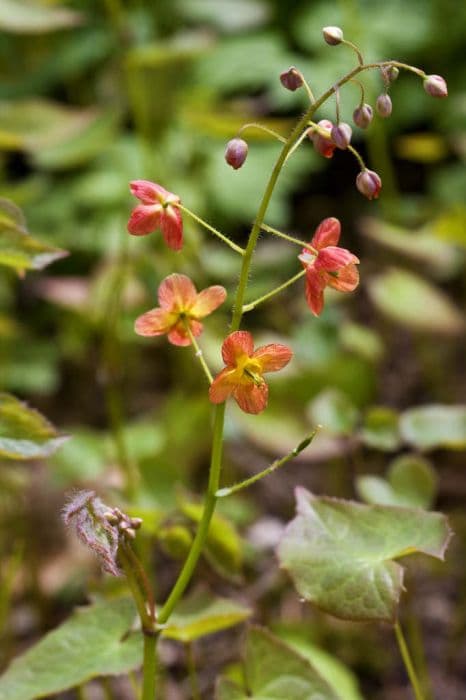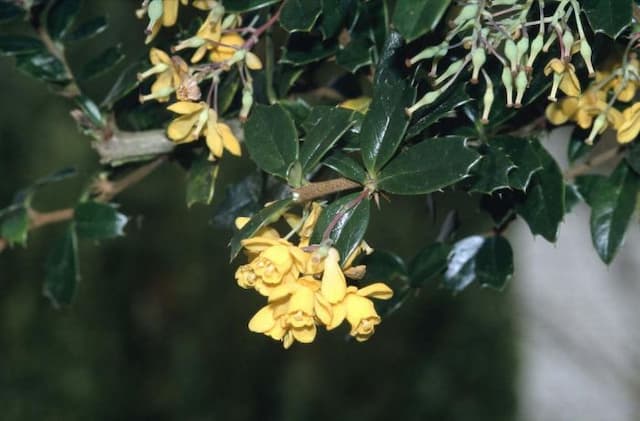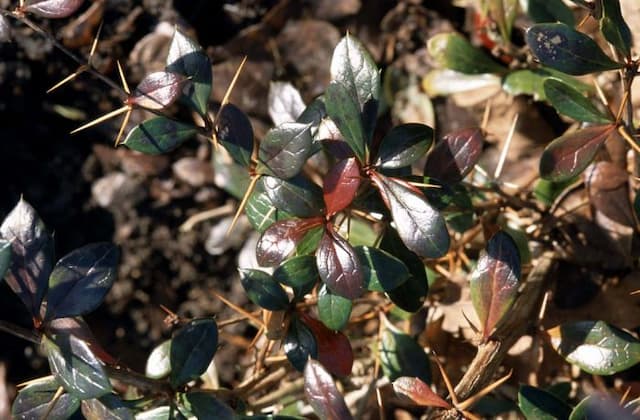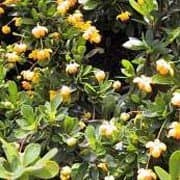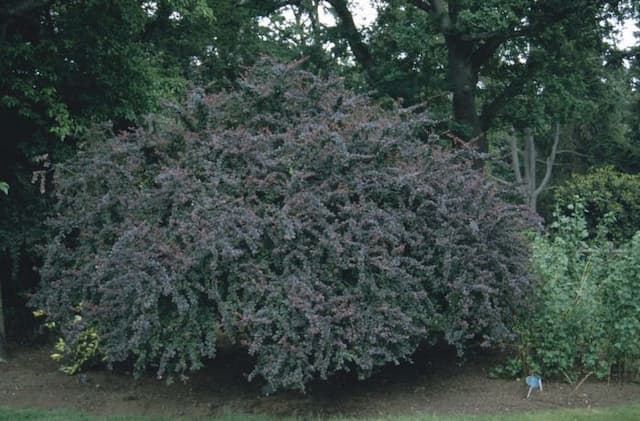Japanese Barberry Berberis thunbergii 'Starburst' (PBR) (v)
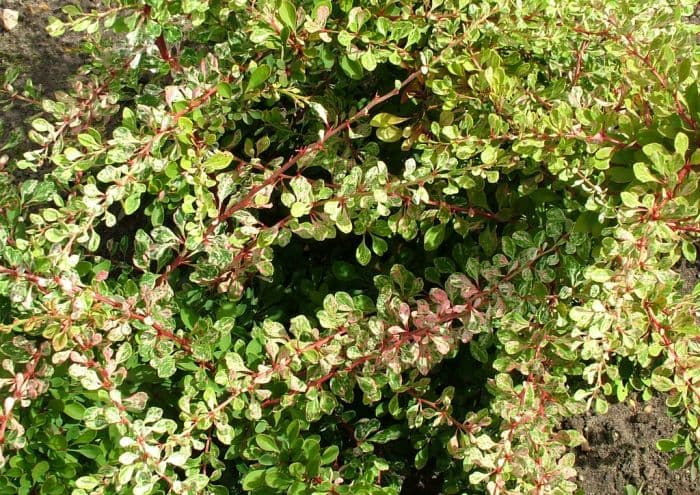
ABOUT
Berberis thunbergii 'Starburst', commonly known as Japanese Barberry, is a visually striking shrub known for its vibrant foliage. This particular cultivar showcases leaves that are variegated, meaning they possess more than one color. The foliage typically presents a combination of bright yellow and green patterns, which can give the appearance of star-like bursts—hence the name 'Starburst'. As the seasons progress, the leaves may develop a range of hues from their initial bright colors to deeper, warmer tones, possibly incorporating shades of orange or red, especially in the fall. The Japanese Barberry 'Starburst' is also decorated with small, sharp spines along its branches, which can act as a deterrent to animals. This shrub may produce tiny, inconspicuous flowers that are usually yellow or red. Following the flowering stage, the shrub can bear small, bright red berries, which can add to its ornamental value and attract birds and wildlife. Overall, its distinctive coloration and year-round appeal make the Japanese Barberry 'Starburst' a popular choice for gardeners looking to add a splash of color to their landscape without mention of the plant's dimensions.
About this plant
 Names
NamesSynonyms
Japanese Barberry, Thunberg's Barberry, Red Barberry.
Common names
Berberis thunbergii 'Starburst' (PBR) (v).
 Toxicity
ToxicityTo humans
The Japanese Barberry is not typically considered highly toxic to humans. However, like many plants, if ingested in large quantities, it can potentially cause gastrointestinal discomfort, including nausea, vomiting, or diarrhea. It is always advisable to avoid eating any parts of ornamental plants due to potential risks and the possibility of individual sensitivities or allergies.
To pets
Japanese Barberry is not known to be highly toxic to pets. However, ingestion of significant quantities of the plant may cause mild gastrointestinal upset in some animals, similar to humans, leading to symptoms such as vomiting or diarrhea. It is prudent to prevent pets from consuming garden plants, as individual reactions can vary, and some animals might be more sensitive.
 Characteristics
CharacteristicsLife cycle
Perennials
Foliage type
Deciduous
Color of leaves
Variegated
Flower color
Yellow
Height
4 feet (1.22 meters)
Spread
4 feet (1.22 meters)
Plant type
Shrub
Hardiness zones
4
Native area
Japan
Benefits
 General Benefits
General Benefits- Ornamental Appeal: Offers visual interest with bright, variegated foliage and a burst of color in the landscape.
- Low Maintenance: Requires minimal care once established, making it a convenient choice for busy gardeners.
- Drought Tolerance: Can survive with limited water, reducing the need for frequent watering.
- Compact Size: Its relatively small stature allows it to fit into smaller gardens or spaces without overwhelming them.
- Seasonal Interest: Provides year-round interest with changing leaf colors and fall berries.
- Wildlife Attraction: Berries produced can attract birds, offering ecological benefits and supporting biodiversity.
- Deer Resistance: Tends to be resistant to deer, reducing the likelihood of damage in areas with deer populations.
 Medical Properties
Medical PropertiesThis plant is not used for medical purposes.
 Air-purifying Qualities
Air-purifying QualitiesThis plant is not specifically known for air purifying qualities.
 Other Uses
Other Uses- Natural Dye: The bright red berries of the Japanese Barberry can be used to produce a natural dye for fabrics, yielding varying hues of yellow, green, and orange depending on the mordant used.
- Photography: The striking foliage of 'Starburst' can be used as a background or accent in garden photography, providing contrast and interest to the composition.
- Artistic Inspiration: The plant's vibrant coloration can serve as inspiration for artists and designers, influencing color palettes and patterns in their work.
- Privacy Barrier: When planted in rows, Japanese Barberry can act as a privacy screen, its dense foliage deterring unwanted views into private spaces.
- Wildlife Shelter: The thorny branches provide a safe nesting environment for birds, protecting them from predators.
- Terrariums: Smaller branches and leaves can be incorporated into terrariums for a miniature landscape effect, providing both color and structure.
- Theme Gardens: Japanese Barberry can be included in Asian-themed gardens to add authenticity and contribute to the overall aesthetic of the landscape design.
- Festive Decorations: The bright berries and foliage can be used to create natural holiday decorations, such as wreaths or table centerpieces.
- Erosion Control: The plant's extensive root system can help to stabilize soil on slopes and prevent erosion.
- Culinary Garnish: Though not a common culinary ingredient, the edible berries can be used as a colorful garnish for plates or drinks.
Interesting Facts
 Feng Shui
Feng ShuiThe Japanese Barberry is not used in Feng Shui practice.
 Zodiac Sign Compitability
Zodiac Sign CompitabilityThe Japanese Barberry is not used in astrology practice.
 Plant Symbolism
Plant Symbolism- Purification: In various cultures, the barberry plant is often associated with cleansing and purging of negativity, likely due to its sharp thorns which are seen as a means to repel negative forces.
- Protection: The thorns of the plant also symbolize protection, serving as a physical barrier, and thereby making it a symbol of safeguarding one's personal space or property.
- Sharpness: The distinct, pointed thorns can symbolize intellectual sharpness or clarity, suggesting a keen mind or thought.
- Adaptability: Being a hardy plant that adapts well to different conditions, the barberry can symbolize resilience and the ability to thrive in various environments.
- Patience: The plant, with its seasonal cycles of growth and dormancy, often signifies patience and the understanding that time brings change.
 Water
WaterJapanese Barberry 'Starburst' prefers evenly moist soil, but it's tolerant of some drought once established. During the growing season, water the plant thoroughly once a week, ensuring that the soil is moist at a depth of 1-2 inches. In times of extreme heat or drought, you may need to water it twice a week. Each watering session should provide 1 to 2 gallons of water, depending on the size and maturity of the shrub. Reduce watering in the fall and water sparingly during winter, as the plant requires less moisture during dormancy.
 Light
LightJapanese Barberry 'Starburst' thrives best in full sun to partial shade. An ideal spot would provide at least 6 hours of direct sunlight each day, ensuring vibrant foliage color and good plant health. It can tolerate some shade, but too much can lead to less vibrant leaf coloration and a reduction in the plant's overall vigor.
 Temperature
TemperatureJapanese Barberry 'Starburst' is hardy and can withstand a range of temperatures, typically thriving in USDA hardiness zones 4 through 8. It can survive minimum temperatures as low as -30 to -20 degrees Fahrenheit and is quite adaptable to heat, though extreme temperatures above 95 degrees Fahrenheit might stress the plant. The ideal temperature for robust growth is between 60 and 70 degrees Fahrenheit.
 Pruning
PruningPruning Japanese Barberry 'Starburst' is essential to maintain its shape and promote healthier, thicker growth. Prune in late winter or early spring before new growth starts, removing dead branches and thinning out dense areas to allow light and air circulation. Pruning can also be done after the plant has flowered to shape the shrub and encourage new growth. It's generally sufficient to prune once a year unless shaping is desired throughout the growing season.
 Cleaning
CleaningAs needed
 Soil
SoilJapanese Barberry 'Starburst' thrives in well-drained soil with a mix of loam, sand, and organic matter; aim for a pH between 6.0 and 7.5 for optimal growth.
 Repotting
RepottingJapanese Barberry 'Starburst' should be repotted every 2-3 years, in spring or fall, to ensure continued health and vigor.
 Humidity & Misting
Humidity & MistingJapanese Barberry 'Starburst' is not particularly humidity sensitive and does well in average outdoor humidity levels.
 Suitable locations
Suitable locationsIndoor
Ensure bright light, minimal watering, and cool winters.
Outdoor
Plant in sun to part-shade; protect from harsh winds.
Hardiness zone
4-8 USDA
 Life cycle
Life cycleBerberis thunbergii 'Starburst', commonly known as Japanese Barberry 'Starburst', starts its life as a seed, which, upon germination, grows into a young seedling. The seedling develops into a juvenile plant, characterized by rapid growth and the development of foliage with its distinctive variegation. As it matures, the plant enters a vegetative stage where it focuses on increasing its size and producing dense, spiny branches. Once it reaches maturity, Japanese Barberry 'Starburst' enters the reproductive phase, blooming with yellow flowers in late spring, which are then followed by the production of small, bright red berries in the fall. These berries serve as a means of dispersal, as birds and other animals eat them and disperse the seeds. The plant may go through this reproductive cycle annually, and with proper care and conditions, it can live for many years before eventually senescing.
 Propogation
PropogationPropogation time
Early Spring
Berberis thunbergii 'Starburst', also known as Japanese barberry 'Starburst', is typically propagated by softwood cuttings. The ideal time for this method is late spring to early summer, when new growth is still tender. To propagate, select a healthy, new growth shoot and cut a section approximately 4 to 6 inches (10 to 15 centimeters) in length. Remove the leaves from the bottom half of the cutting and dip the cut end into rooting hormone powder to enhance root development. The cutting should then be placed in a well-draining potting mix, ensuring that at least two sets of leaf nodes are below the surface. Keep the soil moist but not waterlogged, and provide a warm environment with indirect sunlight. Roots typically develop within a few weeks, after which the new plant can eventually be hardened off and transplanted outdoors.

